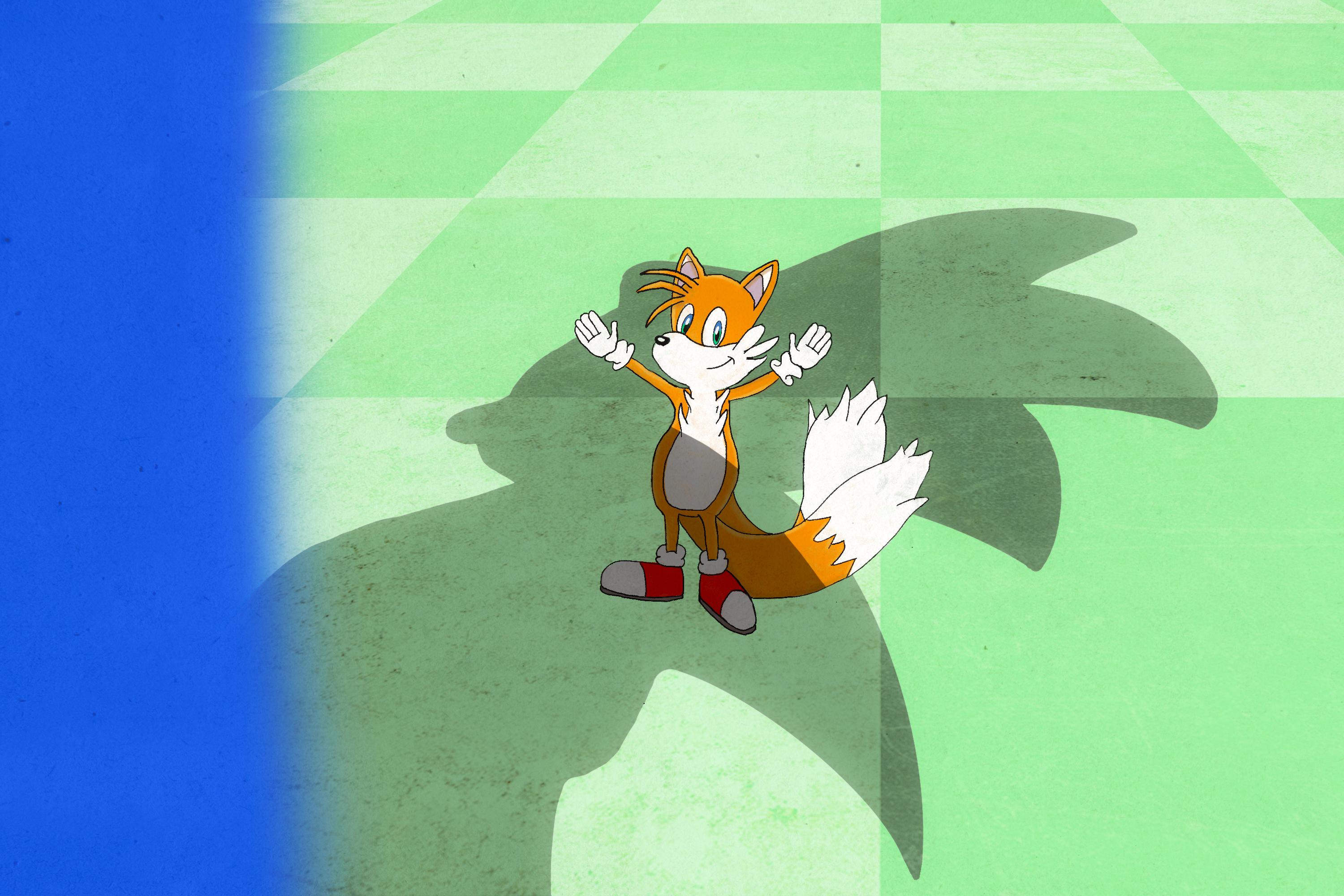Character Study: Tails, the Ultimate Sidekick and Star of Some of the Strangest Fanfic Around
The orange (or is it brown?) fox was created to play Luigi to Sonic the Hedgehog’s Mario. But as his run through our bracket has shown, he’s got a strong identity of his own, even if Sega doesn’t understand that.
This week on The Ringer, we’re hosting the Best Video Game Character Bracket—an expansive competition between the greatest heroes, sidekicks, and villains of the gaming world. And along with delving into some of those iconic figures, we’ll also explore and celebrate the gaming industry as a whole. Welcome to Video Game Week.
If you had an older sibling when the Sonic the Hedgehog 2 cartridge hit your Sega Genesis, you never played as Sonic. You played as Miles “Tails” Prower, Sonic’s brand-new sidekick. As Player 1 sped Sonic through glorious 16-bit landscapes, Player 2 could jump around and grab rings as a plucky two-tailed fox. Tails was a clear second fiddle. He existed solely to aid Sonic’s progress. Tails couldn’t even “die” on his own. The camera followed only Sonic. Whenever Sonic left Tails behind, you had to wait until the game flew Tails back into frame to continue controlling him. He was inserted into the game just to keep younger siblings like me from futilely whining that it was “my turn” to play. And it worked. Shockingly, in my potentially inaccurate recollection, I never whined, because I was able to hop into the game at any moment and play the role of sidekick. I celebrated our shared slot-machine luck in Casino Night Zone while shouldering none of the responsibility for inexcusably early demises in Emerald Hill Zone. It was a familiar, if not comfortable, dynamic for younger siblings everywhere.
Sega created Sonic as an answer to Nintendo’s Mario. And although Sonic is known for collecting rings, his primary mission was to sell Genesis consoles. To the surprise of many in the industry, he did just that. Sega made a dent in Nintendo’s seemingly impenetrable market share and Sonic became the face of Sega, just as planned. Sonic the Hedgehog was a massive hit. Since Sega had created a character who could rival Super Mario, it figured, surely it could create a sidekick at least as cool as Luigi. An internal design competition yielded Miles “Tails” Prower, the two-tailed flying fox. There was some initial dispute about whether his name would be Miles Prower or Tails, but a compromise was eventually reached. Tails proved to be the name with the most staying power, but it’s easy to appreciate the miles-per-hour wordplay of Miles Prower.
It’s been almost 30 years since Tails debuted in Sonic 2, and in that time, the beloved fox (who is crushing it in our Video Game Character Bracket at the moment) has managed to star in only three games of his own: Tails Adventure, Tails’ Skypatrol, and Tails and the Music Maker. Tails Adventure was released, in 1995, during the dying days of Game Gear—Sega’s unsuccessful attempt at a Game Boy killer. (Six AA batteries for four hours of playtime!) Tails’ Skypatrol was also released in 1995 on Game Gear, but only in Japan. Tails and the Music Maker was released on a trivia answer of a console: Sega Pico, Sega’s educational kids computer. Despite the fact that the video game world’s other famous sidekick has a number of successful solo games, Tails has never really had any significant time in the spotlight. A pitch for a game named Treasure Tails was made in 1993, but it never came to be. Even divisive antihero Shadow the Hedgehog got a solo game (that critics mostly hated). Tails has had a significant presence in almost every Sonic game, but much like his function in Sonic 2, it’s been mostly in service of Sonic.
From Tails’s genesis (sorry), he’s been overlooked. Just look at how many times Sonic is referenced in the Tails origin story that appeared on page 3 of the Sonic 2 instruction booklet. The entire backstory of the character was essentially “Tails is obsessed with Sonic and always tries to copy him.” (Typical little sibling behavior.) Like most games of the early ’90s, the Sonic series wasn’t exactly a great work of fiction, and Sega didn’t seem to care much about keeping its characters or stories consistent between the games, comic books, and cartoons that followed Sonic 2’s success. The animated series Adventures of Sonic the Hedgehog debuted in late 1993, almost a year after Sonic 2’s release, and featured a brown version of Tails despite Tails’s debut in Sonic 2 as much more orange. Two different Sonic comic series debuted in 1993, and Tails was brown in one and orange in the other. Sega handed off the characters to a bunch of different people and let them all walk in different directions. For a game series known more for its gameplay than its story, it might surprise you to learn that there are hundreds of issues of Sonic comics and hundreds of episodes of Sonic TV shows. There is so much Sonic and Tails lore outside of the actual video games, across so many different, conflicting cartoons and comics, that the Wiki pages keeping track of everything have banners at the top of character pages letting you know which version of Sonic reality the character exists in. The one constant throughout all of the various Tails origin stories is that he had a very rough time before Sonic entered the picture.
While Sega hasn’t been a fierce defender of Sonic and Tails continuity, it also hasn’t really defended the Sonic and Tails intellectual property. Nintendo seems to delight in sending out cease and desist letters to well-meaning fans, but Sonic and Tails fan fiction, fan art, and fan video communities are stunningly massive and completely out of control. Tails love abounds within these communities, sometimes in distressingly explicit ways. (No, I am not going to link.) Sega might not give us enough Tails, but you still have access to 5,139 works of Tails fan fiction (many of which are erotic) across 12 languages. You can also find fan-made Tails YouTube videos on channels that have hundreds of thousands of subscribers. There are expensive-looking videos of Tails getting deep in his feels about the past, but even fan videos with lower production value often have millions of views. Two and a half million viewers watched a video in which voice actors playing the roles of Sonic and Tails react to DeviantArt drawings of the characters suggestively embracing. This is canon, right? Tails belongs to the people.
If you cast aside all of the cringey (and erotic) elements of the Sonic and Tails fan communities, you’ll find that they care very much about Tails, in particular. Tails speaks to anyone who has been unwillingly ushered into a sidekick role. He overcame his fears, his insecurities, and bouts of bullying to become a hero. The Tails of the thousands upon thousands of fan-generated Sonic realities is more often Sonic’s equal than his sidekick. When Sonic leaves the frame, the camera stays on Tails. When the sequel to 2020’s Sonic the Hedgehog movie comes out next year, and heavily features Tails, it’ll be interesting to see which version of Tails we get.
Hopefully it’s not the erotic one.

